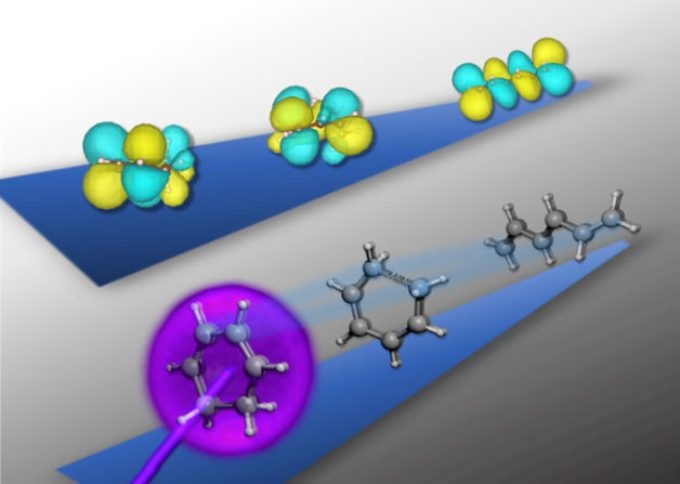Apr 7 2017
Researchers have been able to capture the ephemeral electron movements in a transient state of a reaction vital in optoelectronic and biochemical procedures, and for the first time, could directly characterize it using ultrafast X-ray spectroscopy at the Department of Energy’s Lawrence Berkeley National Laboratory (Berkeley Lab).
 Upon light activation (in purple, bottom row's ball-and-stick diagram), the cyclic structure of the 1,3-cyclohexadiene molecule rapidly unravels into a near-linear shape in just 200 femtoseconds. Using ultrafast X-ray spectroscopy, researchers have captured in real time the accompanying transformation of the molecule's outer electron "clouds" (in yellow and teal, top row's sphere diagram) as the structure unfurls. (Credit: Kristina Chang/Berkeley Lab)
Upon light activation (in purple, bottom row's ball-and-stick diagram), the cyclic structure of the 1,3-cyclohexadiene molecule rapidly unravels into a near-linear shape in just 200 femtoseconds. Using ultrafast X-ray spectroscopy, researchers have captured in real time the accompanying transformation of the molecule's outer electron "clouds" (in yellow and teal, top row's sphere diagram) as the structure unfurls. (Credit: Kristina Chang/Berkeley Lab)
Similar to a number of rearrangements of molecular structures, the ring-opening reactions in this research occur on timescales of hundreds of femtoseconds (1 femtosecond equals a millionth of a billionth of a second). The research team was able to gather photos of the electronic structure during the reaction by using femtosecond pulses of X-ray light on a tabletop apparatus.
The experiments are explained in the April 7 issue of the Science journal.
“Much of the work over the past decades characterizing molecules and materials has focused on X-ray spectroscopic investigations of static or non-changing systems,” said study principal investigator Stephen Leone, faculty scientist at Berkeley Lab’s Chemical Sciences Division and UC Berkeley professor of chemistry and physics. “Only recently have people started to push the time domain and look for transient states with X-ray spectroscopy on timescales of femtoseconds.”
The researchers concentrated on the structural rearrangements that take place when a molecule called 1,3 cyclohexadiene (CHD) is activated by light, causing a higher-energy rearrangement of electrons, referred to as an excited state. In this excited state, the cyclic molecule of six carbon atoms in a ring transforms into a linear six-carbon chain molecule. The ring-opening is driven by a very quick exchange of energy between the motions of the new, dynamic electronic configuration and the atomic nuclei.
This light-activated, ring-opening reaction of cyclic molecules is a universal chemical process that is a main step in in optoelectronic technologies fundamental to optical data storage, optical switching, and photochromic devices, and in the photobiological synthesis of vitamin D in the skin.
So as to characterize the electronic structure during the ring-opening reaction of CHD, the team exploited the exclusive capabilities of X-ray light as a robust tool for chemical analysis. During their experiments, the researchers used an UV pump pulse to stimulate the reaction and then probe the development of the reaction at a controllable time delay using the X-ray flashes. At a given time delay subsequent to the UV light exposure, the researchers measure the wavelengths (or energies) of X-ray light that are absorbed by the molecule in a method referred as time-resolved X-ray spectroscopy.
The key to our experiment is to combine the powerful advantages of X-ray spectroscopy with femtosecond time resolution, which has only recently become possible at these photon energies. We used a novel instrument to make an X-ray spectroscopic ‘movie’ of the electrons within the CHD molecule as it opens from a ring to a linear configuration. The spectroscopic still frames of our ‘movie’ encode a fingerprint of the molecular and electronic structure at a given time.
lead author Andrew Attar, a UC Berkeley Ph.D. student in chemistry.
So to clearly decode the spectroscopic fingerprints that were witnessed experimentally, a series of theoretical simulations were conducted by researchers at Berkeley Lab’s Molecular Foundry and the Theory Institute for Materials and Energy Spectroscopies (TIMES) at DOE’s SLAC National Accelerator Laboratory. The simulations demonstrated both the ring-opening process and the interaction of the X-rays with the molecule during its transformation.
“The richness and complexity of dynamical X-ray spectroscopic signatures such as the ones captured in this study require a close synergy with theoretical simulations that can directly model and interpret the experimentally observed quantities,” said Das Pemmaraju, project scientist at Berkeley Lab’s Chemical Sciences Division and an associate staff scientist at TIMES.
The application of femtosecond X-ray pulses on a laboratory benchtop scale is one of the chief technological milestones to materialize from this research.
We have used a tabletop, laser-based light source with pulses of X-rays at energies that have so far been limited only to large-facility sources.
Attar.
The X-ray pulses are generated using a method known as high-harmonic generation, where the infrared frequencies of a commercial femtosecond laser are concentrated into a helium-filled gas cell and, via a nonlinear interaction with the helium atoms, are up-converted to X-ray frequencies. The infrared frequencies were increased by a factor of approximately 300.
The researchers are currently utilizing the instrument to examine numerous light-activated chemical reactions with a specific focus on reactions that are applicable to combustion.
“These studies promise to expand our understanding of the coupled evolution of molecular and electronic structure, which lies at the heart of chemistry,” said Attar.
Other co-authors of the study are Aditi Bhattacherjee and Kirsten Schnorr at Berkeley Lab’s Chemical Sciences Division and UC Berkeley’s Department of Chemistry; and Kristina Closser and David Prendergast at Berkeley Lab’s Molecular Foundry.
The research was primarily supported by DOE’s Office of Science. The Molecular Foundry is a DOE Office of Science User Facility.